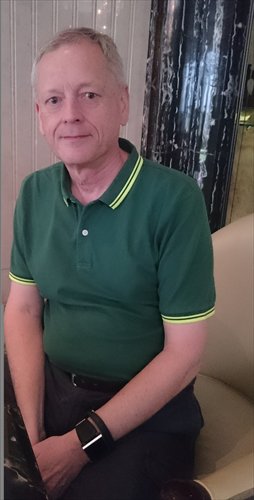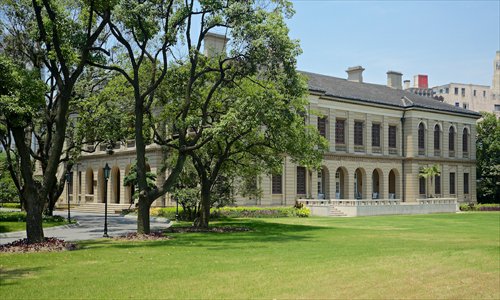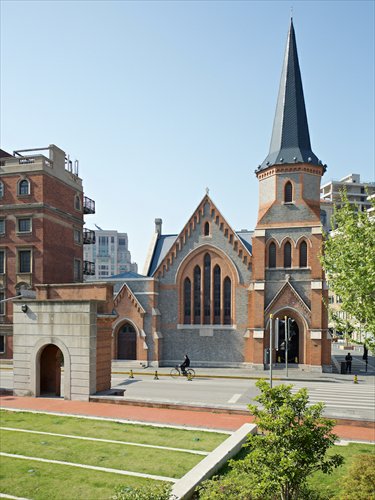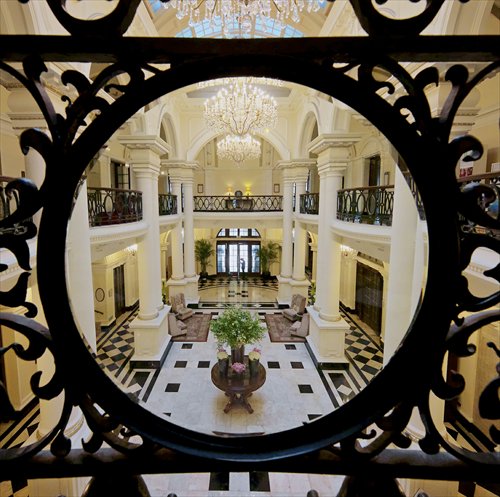HOME >> METRO SHANGHAI
Photographing history
By Louise Ho Source:Global Times Published: 2015-7-23 18:43:01
Many foreign visitors are fascinated by the historical architecture found around the city in neighborhoods such as the Bund, but few have had the determination to not just start but complete a project to visually document Shanghai's surviving historical buildings.
Enter Nicholas Kitto, a retired chartered accountant and amateur photographer based in Hong Kong who now devotes his autumn years to recording the preservation of historical buildings in the former treaty ports of China, including Shanghai.
After seven years of photographing China, Kitto now has a substantial collection of 10,000 images and counting. Though he could stop here, Kitto told the Global Times that it is his mission "to cover as many buildings as possible."
Kitto's epic project requires him to make frequent visits to Shanghai, including his recent trip to the Bund as well as the former YMCA building on Nanjing Road West and the Union Church on Suzhou Road South, a Gothic-style Protestant church built in 1886 which was devastated by a fire in 2007.
He explained that some structures are still what they always have been, such as the former HSBC Building, which is now occupied by Shanghai Pudong Development Bank, while many others have been completely overhauled. A few former apartment buildings are now hotels, like the Broadway Mansions Hotel on Suzhou Road North, and some have even been converted into shops and restaurants, such as the Butterfield & Swire office, which is currently called Bund 22.
"Many of these old buildings are put to good use regardless of what they've been through," Kitto said.
Family roots
The idea of starting a photography project was inspired by friend Robert Nield in 2008, when Kitto took photos for his short book on the history of the first five treaty ports in China. Kitto has expanded on that concept by photographing every treaty port across the country.
But Kitto, who hails from the Isle of Man, is also using the project to trace his own family's century-long history with the country. When he first started to travel through the Chinese mainland in 1996, his father John Kitto wrote him extensive notes about the family's time in China. Through his own research, he found that his families' activities in China go back to 1867.
"In researching the Kitto family's lives and times in some of these ports, I found myself increasingly photographing buildings from those days," he said.
Through the help of his family and other archives, Kitto has tracked down the locations of his family's activities in Shanghai and other parts of China. As it turns out, John was born in Tianjin, in 1925. His grandfather Jack worked for a Shell subsidiary, the Asiatic Petroleum Company, in central and northern China from 1912 until his retirement in 1939.
Jack held his farewell party at the Shanghai Club, of which he was a member, when he decided to leave due to the war. During Kitto's recent visit to Shanghai, he chose to stay at the former Shanghai Club, which is now the Waldorf Astoria Hotel.
Surviving the times
The preservation of historical buildings is a major task for the Shanghai government, and Kitto said the city is doing "a wonderful job" in restoring its old buildings. "There is a good balance in preserving historical interests and going forward," he said.
It is fascinating for Kitto to see how these buildings have survived through the times and tumult during which they were built. "There was World War II, then the Civil War and Cultural Revolution (1966-76), but the buildings still survived," he said.
Kitto says one of his favorite old buildings in Shanghai is the former British Consulate on Zhongshandongyi Road, next to the recently restored Garden Bridge. Built in 1873, the building is now the private Finance Club.
He is not alone in his love for the city's colonial past. Other foreigners before him have also documented Shanghai's architecture, such as Tess Johnston in the 1990s, who published 15 books with photographer Deke Erh about Western architecture in old China.
"My advantage is that many of these buildings now have been restored to what they were," Kitto said.
Kitto continues to revisit Shanghai as well as Guangzhou, Tianjin, Qingdao and other port cities on different occasions as he works toward completing his ambitious project. "My passport is almost entirely full of PRC immigration entry and exit chops!" he laughed.
In addition to his own project, Kitto is also helping other photographers pursue theirs' through a twice-annual grant valued at $5,000, The Nicholas Kitto Grant For Emerging Photographers In Greater China, which is funded in conjunction with The Luminous Endowment for Photographers.
The benevolent Brit says he plans to pay many more visits to Shanghai in the months ahead, though it's impossible for him to determine when enough is enough. "I could spend a year living here and still not be able to cover Shanghai properly," he said.
A gallery of Kitto's work can be viewed on his website: http://nicholaskitto.com.




Enter Nicholas Kitto, a retired chartered accountant and amateur photographer based in Hong Kong who now devotes his autumn years to recording the preservation of historical buildings in the former treaty ports of China, including Shanghai.
After seven years of photographing China, Kitto now has a substantial collection of 10,000 images and counting. Though he could stop here, Kitto told the Global Times that it is his mission "to cover as many buildings as possible."
Kitto's epic project requires him to make frequent visits to Shanghai, including his recent trip to the Bund as well as the former YMCA building on Nanjing Road West and the Union Church on Suzhou Road South, a Gothic-style Protestant church built in 1886 which was devastated by a fire in 2007.
He explained that some structures are still what they always have been, such as the former HSBC Building, which is now occupied by Shanghai Pudong Development Bank, while many others have been completely overhauled. A few former apartment buildings are now hotels, like the Broadway Mansions Hotel on Suzhou Road North, and some have even been converted into shops and restaurants, such as the Butterfield & Swire office, which is currently called Bund 22.
"Many of these old buildings are put to good use regardless of what they've been through," Kitto said.
Family roots
The idea of starting a photography project was inspired by friend Robert Nield in 2008, when Kitto took photos for his short book on the history of the first five treaty ports in China. Kitto has expanded on that concept by photographing every treaty port across the country.
But Kitto, who hails from the Isle of Man, is also using the project to trace his own family's century-long history with the country. When he first started to travel through the Chinese mainland in 1996, his father John Kitto wrote him extensive notes about the family's time in China. Through his own research, he found that his families' activities in China go back to 1867.
"In researching the Kitto family's lives and times in some of these ports, I found myself increasingly photographing buildings from those days," he said.
Through the help of his family and other archives, Kitto has tracked down the locations of his family's activities in Shanghai and other parts of China. As it turns out, John was born in Tianjin, in 1925. His grandfather Jack worked for a Shell subsidiary, the Asiatic Petroleum Company, in central and northern China from 1912 until his retirement in 1939.
Jack held his farewell party at the Shanghai Club, of which he was a member, when he decided to leave due to the war. During Kitto's recent visit to Shanghai, he chose to stay at the former Shanghai Club, which is now the Waldorf Astoria Hotel.
Surviving the times
The preservation of historical buildings is a major task for the Shanghai government, and Kitto said the city is doing "a wonderful job" in restoring its old buildings. "There is a good balance in preserving historical interests and going forward," he said.
It is fascinating for Kitto to see how these buildings have survived through the times and tumult during which they were built. "There was World War II, then the Civil War and Cultural Revolution (1966-76), but the buildings still survived," he said.
Kitto says one of his favorite old buildings in Shanghai is the former British Consulate on Zhongshandongyi Road, next to the recently restored Garden Bridge. Built in 1873, the building is now the private Finance Club.
He is not alone in his love for the city's colonial past. Other foreigners before him have also documented Shanghai's architecture, such as Tess Johnston in the 1990s, who published 15 books with photographer Deke Erh about Western architecture in old China.
"My advantage is that many of these buildings now have been restored to what they were," Kitto said.
Kitto continues to revisit Shanghai as well as Guangzhou, Tianjin, Qingdao and other port cities on different occasions as he works toward completing his ambitious project. "My passport is almost entirely full of PRC immigration entry and exit chops!" he laughed.
In addition to his own project, Kitto is also helping other photographers pursue theirs' through a twice-annual grant valued at $5,000, The Nicholas Kitto Grant For Emerging Photographers In Greater China, which is funded in conjunction with The Luminous Endowment for Photographers.
The benevolent Brit says he plans to pay many more visits to Shanghai in the months ahead, though it's impossible for him to determine when enough is enough. "I could spend a year living here and still not be able to cover Shanghai properly," he said.
A gallery of Kitto's work can be viewed on his website: http://nicholaskitto.com.

British photographer Nicholas Kitto
Photo: Louise Ho/GT

The former British Consulate

The Union Church

The lobby of the Waldorf Astoria Hotel
Photos: Courtesy of Nicholas Kitto
Posted in: Metro Shanghai